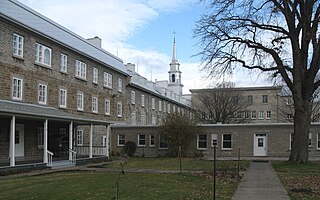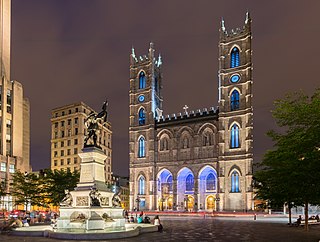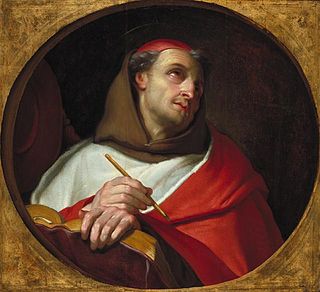Notre Dame, French for "Our Lady", a title of Mary, mother of Jesus, most commonly refers to:

Verdun is a borough (arrondissement) of the city of Montreal, Quebec, located in the southeastern part of the island.

The Cathedral-Basilica of Notre-Dame de Québec, located at 16, rue de Buade, Quebec City, Quebec, is the primatial church of the Roman Catholic Archdiocese of Quebec. It is the oldest church in Canada and was the first church in Canada to be elevated to the rank of minor basilica, by Pope Pius IX in 1874. Four governors of New France and the bishops of Quebec are buried in the crypt, including François de Laval, Quebec's first bishop.

Old Montreal is a historic neighbourhood within the municipality of Montreal in the province of Quebec, Canada. Home to the Old Port of Montreal, the neighbourhood is bordered on the west by McGill Street, on the north by Ruelle des Fortifications, on the east by rue Saint-André, and on the south by the Saint Lawrence River. Following recent amendments, the neighbourhood has expanded to include the Rue des Soeurs Grises in the west, Saint Antoine Street in the north, and Saint Hubert Street in the east.

Old Quebec is a historic neighbourhood of Quebec City, Quebec, Canada. Comprising the Upper Town and Lower Town, the area is a UNESCO World Heritage Site. Administratively, Old Quebec is part of the Vieux-Québec–Cap-Blanc–colline Parlementaire district in the borough of La Cité-Limoilou.

Notre-Dame-des-Anges is a parish municipality in Quebec, Canada, home of the General Hospital of Quebec.

The Old Quebec Funicular is an inclined elevator, formerly a funicular railway, in the Old Quebec neighbourhood of Quebec City, Quebec, Canada. It links the Haute-Ville at Dufferin Terrace to the Basse-Ville at Rue du Petit-Champlain. The Basse-Ville includes such sites as the colonial-era Notre Dame des Victoires church, the historic Petit Champlain district, the port, and the Musée de la civilisation. Climbing at a 45-degree angle, the railway covers a total distance of 64 metres (210 ft).

Notre-Dame Basilica is a minor basilica of the Catholic Church in the historic Old Montreal district of Montreal in Quebec, Canada. It is located at 110 Notre-Dame Street West, at the corner of Saint Sulpice Street. It is situated next to the Saint-Sulpice Seminary and faces the Place d'Armes square.
This is a timeline of the history of Quebec City.
The timeline of Montreal history is a chronology of significant events in the history of Montreal, Canada's second-most populated city, with about 3.5 million residents in 2018, and the fourth-largest French-speaking city in the world.

Quartier du Petit Champlain is a small commercial zone in Quebec City, Quebec, Canada. It is located in the neighbourhood of Vieux-Québec–Cap-Blanc–colline Parlementaire in the borough of La Cité-Limoilou, near Place Royale and its Notre-Dame-des-Victoires Church. Its main street is the Rue du Petit-Champlain at the foot of Cap Diamant. It is claimed that it's the oldest commercial district in North America.

Vieux-Québec–Cap-Blanc–Colline Parlementaire is one of the 35 districts of the City of Quebec, and one of six that are located in the borough of La Cité-Limoilou. The district is the most visited and toured location in the city. It is in this partly fortified area where the Château Frontenac is found, with its large terrace overlooking the city of Lévis, across the Saint Lawrence River. A large concentration of cafes, tourist shops, restaurants, hotels and inns are situated in the district. In its most recent census count in 2016, Statistics Canada reported that the district had a population of 5,770 residents, whom comprise 1.1% of the city's total population.

Daniel Kern Manufacture d'Orgues were an organ builder based in Strasbourg, France. Their organs were installed in many churches in France and other countries. In addition, the firm undertook restoration work on historic organs.

The Church of Our Lady of Victories at the Sablon, or the Church of Our Lady of the Sablon, is a Roman Catholic church located in the Sablon/Zavel district, in the historic centre of Brussels, Belgium. It is dedicated to Our Lady of the Sablon.

Claude François was a French painter and Recollect Franciscan friar. He is better known as Frère Luc, the name he adopted after becoming a monk.

Notre-Dame-de-la-Visitation is a neo-Romanesque Catholic church on Chemin du Roy in Champlain, Mauricie, Quebec.


















